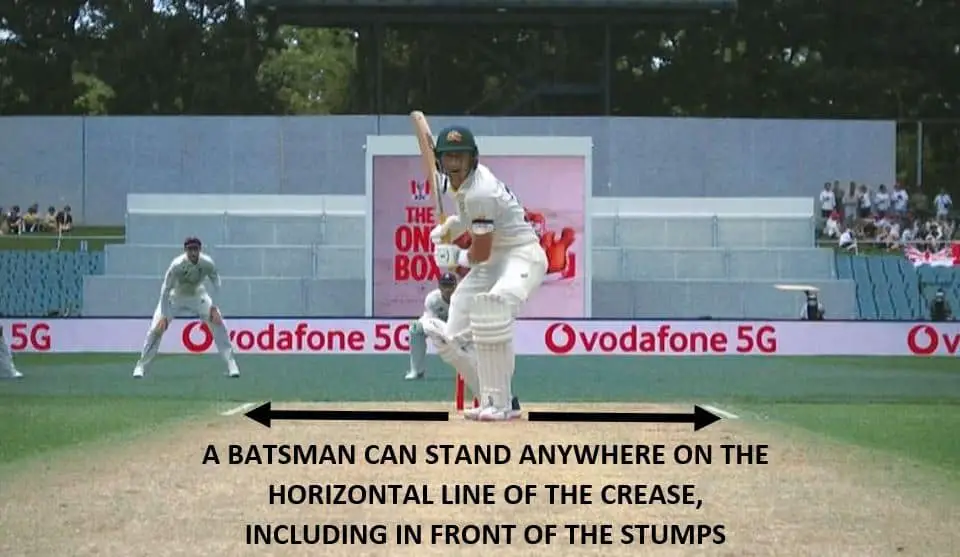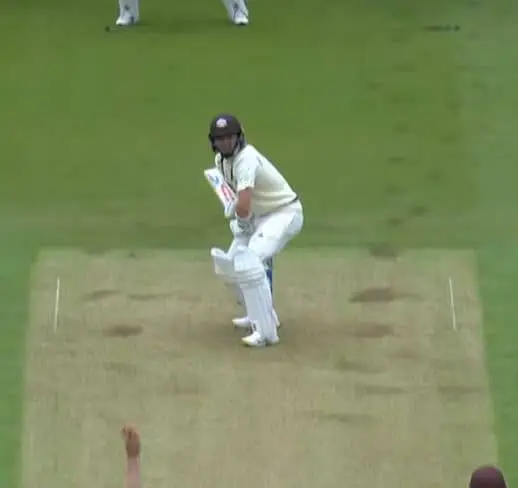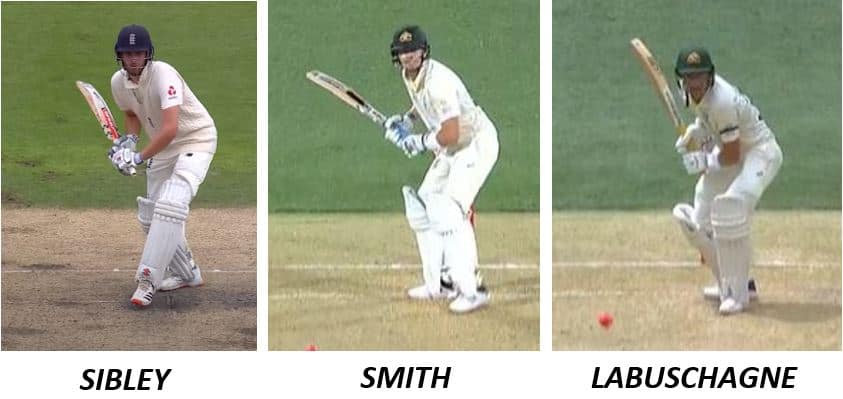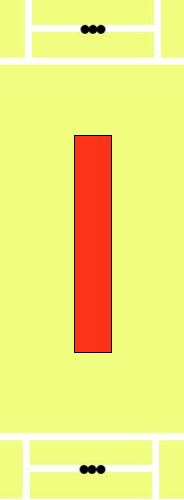When I first started watching cricket in my grandparents’ house as a child, I assumed that the objective of the game was for the bowler to hit the stumps. For this reason, I was incredibly confused when batsmen on the TV would stand in front of the stumps and not allow the bowler to see any of them when they were about to bowl. It just didn’t seem fair! When I was playing cricket in the garden with my family, I would tell them that they needed to stand at the side of the stumps rather than in front of them, so that I had a chance to hit them.
There are a lot of people who are new to the sport that ask the same questions I did when I was a child. Are batsmen allowed to cover their stumps? And if yes, how is that fair for the bowler? Surely this gives batsmen a huge advantage seeing as it stops the ball from hitting the stumps – right? These are the questions that I’ll be dealing with in this post, so if you’re a little confused about all this – stick around!
So, can a batsman cover all of the stumps in cricket?
Yes, it is perfectly within the rules of cricket for a batsman to cover their stumps fully whilst in their batting stance. There are no cricketing laws that regulate where a batsman can position themselves horizontally on the crease, so it is up to each batsman to find a position that works for them.
Therefore, theoretically a batsman can stand wherever they like at the crease. They could stand wide of the leg stump, wide of the off stump, or right in the middle in front of the stumps if they choose to. Some positions will be better than others though! A batsman would be regarded as quite foolish if they got into their batting stance way outside the off stump – even though they are allowed to do so.

Now that you know it is possible for a batsman to stand in front of their stumps, you may be wondering what advantages it gives them. You may also be wondering if there are any disadvantages! Keep reading below if you’d like to get my full breakdown of all this info.
What Advantages Does Covering The Stumps Offer A Batsman?
There are a few main advantages of using a batting stance that allows you to cover your stumps. They are as follows:
- It means you are less likely to be bowled
- It gives you more opportunities to play the ball on the leg side
- It may mean there are less wide balls for you to chase outside off stump
I’ll now go into each of these advantages individually and explain why covering your stumps helps you to achieve them.
Why Does Covering The Stumps Mean You Are Less Likely To Be Bowled?
The answer to this one should be pretty obvious! If a batsman stands in front of the stumps and remains there as the ball is travelling towards them, then there is much less chance that the ball can get past them and hit the stumps. This is why batsmen who find themselves getting bowled regularly may adjust their stances to cover the stumps more.
Why Does Covering The Stumps Give You More Opportunities To Play The Ball On The Leg Side?
Most batsmen will take a middle stump or a middle and leg guard (click here if you’re not sure what ‘taking guard’ is). This means that the off stump will almost always be visible to the bowler. When a batsman moves across to the off side and covers the stumps with their pads, this means that a higher proportion of deliveries will be on the line of the batsman’s body, or just outside. As a result, there will be a higher percentage of balls that the batsman can hit through the leg side.
This is why covering the stumps is good for batsmen who have a strong leg-side game. It gets them across to the off stump and usually means that the bowler will bowl more straight balls. This gives the batsman more chances to hit the ball in their strong areas.
Steve Smith is a batsman who immediately comes to mind when I talk about this. As he’s about to receive the ball Smith gets himself fully in front of the stumps. Bowlers like to bowl straight at him as a result. Because he’s such a strong leg side player, Smith thrives on this type of bowling and is able to rotate the strike and hit boundaries on the leg side easily.
Why Does Covering The Stumps Mean There May Be Less Wide Balls For You To Chase?
As I explained above, when a batsman moves across the crease to cover the stumps there usually ends up being more deliveries that are on the line of the batsman’s body or just outside. This means that bowlers may end up bowling fewer wide balls outside the off stump, and as a result there will be less deliveries that the batsmen feel they can chase in order to hit through the off side. For batsmen who are prone to edging wide balls to the keeper or the slip fielders, having less of these balls bowled to you can be seen as an advantage.
What Are The Disadvantages Of Covering Your Stumps?
With any batting technique, there are always advantages and disadvantages. Choosing to stand in front of the stumps is no different! Here are the main disadvantages of this method:
- You are more likely to get out LBW
- You may have less off-side scoring opportunities
- You may lose your sense of where your off stump is
- It can lead to you playing straight balls with an angled bat
I’ll now explain each of these disadvantages and show you how covering your stumps can lead to them.
Why Does Covering Your Stumps Mean You’re More Likely To Get Out LBW?
If you are covering the stumps with your pads, then you are obviously much more likely to get out LBW than if your pads were not in front of the stumps. A batsman who sets up in this position will have to be extremely comfortable attacking and defending against straight deliveries, because the bowlers will usually be relentless in attacking your pads in the hope that you miss a delivery. If you bat directly in front of the stumps and miss a straight ball, it’s likely the umpire is going to give you out pretty quickly!
Why Does Covering Your Stumps Mean You May Have Less Off-Side Scoring Opportunities?
Some batsmen are very good at striking the ball through the off side. Batsmen who are very good at hitting the ball in this part of the field will probably have less opportunities to do so if they end up covering their stumps whilst in their batting stance. As I’ve already explained, when you move yourself across to the off side and stand in front of the stumps you will usually get slightly more deliveries on the line of your body. Balls that you could have cut and driven through the off side if you were batting on middle stump or middle and leg are now ones that you may have to defend or hit straight when standing in front of the stumps.
Why Does Covering Your Stumps Mean You Could Lose Your Sense Of Where Off Stump Is?
Knowing where your off stump is is an incredibly important aspect of batting. If you instinctively know where your off stump is, you will know which deliveries are safe to leave alone and which ones need to be defended. Most batsmen learn where their off stump is by batting in a position which allows them to get their outside eye directly over the top of the off stump. This usually requires them to take a middle/middle & leg guard. Batting in this position means that any deliveries outside the line of their eye can be left alone, whilst any deliveries inside the line of their eye need to be played at. Again, you can read more about this very interesting subject in my ‘taking guard’ post – which is linked here!
When some batsmen cover their stumps as they get in to their batting stance, they can sometimes end up positioning their head and (more importantly) their eyes outside the line of their off stump. This means that they don’t have an easy way of knowing where their off stump is, and as a result they could end up playing at a lot more balls than they need to. In conditions where the ball is nipping around and batting is tough, this is not something that a batsman really wants to be doing. You can see an example of Ollie Pope covering his stumps and getting his right eye outside the line of the off stump in the picture below.

Why Does Covering Your Stumps Lead To Playing Straight Balls With An Angled Bat?
As we’ve already discussed, when a batsman stands directly in front of the stumps, bowlers will often target their pads with straight deliveries. To hit these deliveries and stop them from striking the pads, the batsman must manoeuvre the bat around the pads, which often requires them to play the shot with an angled bat. The bat will often move diagonally, pointing towards the slips at first and then travelling in the direction of mid-on.
When a batsman does not stand directly in front of the stumps and takes a middle or leg stump guard, it means that their pads are not in the way of the bat if they wanted to defend or attack a straight ball. This means that they can raise the bat in a straight line behind them, and then swing the bat through straight in order to make contact with the ball. This is generally regarded as a much more technically correct way of batting and is seen by many coaches as a technique that sets a batsman up more firmly for success.
Which Professional Players Cover The Stumps?
There are many successful batsmen in modern cricket that like to cover their stumps whilst in their batting stances. The most famous of these is probably Steve Smith, and that’s why I’ve already mentioned him a couple of times in this post! Smith has incredible hand-eye co-ordination, which is one of the reasons that bowlers cannot simply target his pads in order to trap him LBW. A couple of others to look out for are Marnus Labuschagne and Dom Sibley of England, who both like to get right across to the off stump in their batting stance. Going back a bit further, you can see that batsmen like Shivnarine Chanderpaul & Sourav Ganguly often liked to get into similar positions.

The one thing that all of these batsmen have in common is that they’re amazingly skilled at hitting and defending the ball when it is on the line of their pads. If you’re someone who is going to bat in front of the stumps, you will need to make sure that you possess this skill too. It’s something you should spend a lot of hours practicing in the nets! Additionally, I’d recommend studying the players that I’ve mentioned above and seeing if there are any aspects of their techniques that you think you could incorporate into your own game. Professional players are often the best people to learn from!
Are There Any Cricket Laws That Regulate Where The Batsman Is Allowed To Stand?
The only cricket law that stops the batsman from standing in a certain area is the following:
‘The on-strike batsman shall not adopt a stance in the protected area or so close to it that frequent encroachment is inevitable’
If you’re wondering exactly what this means, you’re probably not alone. Basically, it means that the batsman is not allowed to stand so far outside their crease that they end up standing on the protected area of the pitch. Also, even if the batsman stands just outside the protected area, playing a front foot shot could lead to them ending up standing in the protected area – so the umpire will not allow them to get close!
If you want to know where the protected area of the pitch is, it’s shown in the diagram below. It is a rectangular zone about 5 feet away from both popping creases, and it’s 2 feet wide. If you’d like to read a little more about it, along with reasons why batsmen choose to bat outside of their crease and how it can benefit your game – click here!

Conclusion
As I covered above, there are multiple advantages and disadvantages to covering your stumps while batting, so it is up to you to decide whether it will be beneficial to your game. If it is something that you choose to do, then you need to stick with it and make sure you get as much batting practice as possible every week. By doing this, you will ensure that you become comfortable with your setup and will be able to combat the weaknesses of the setup much easier.
If you’d like to read a post that will give you plenty of ideas for ways to practice your batting at home – click here!
